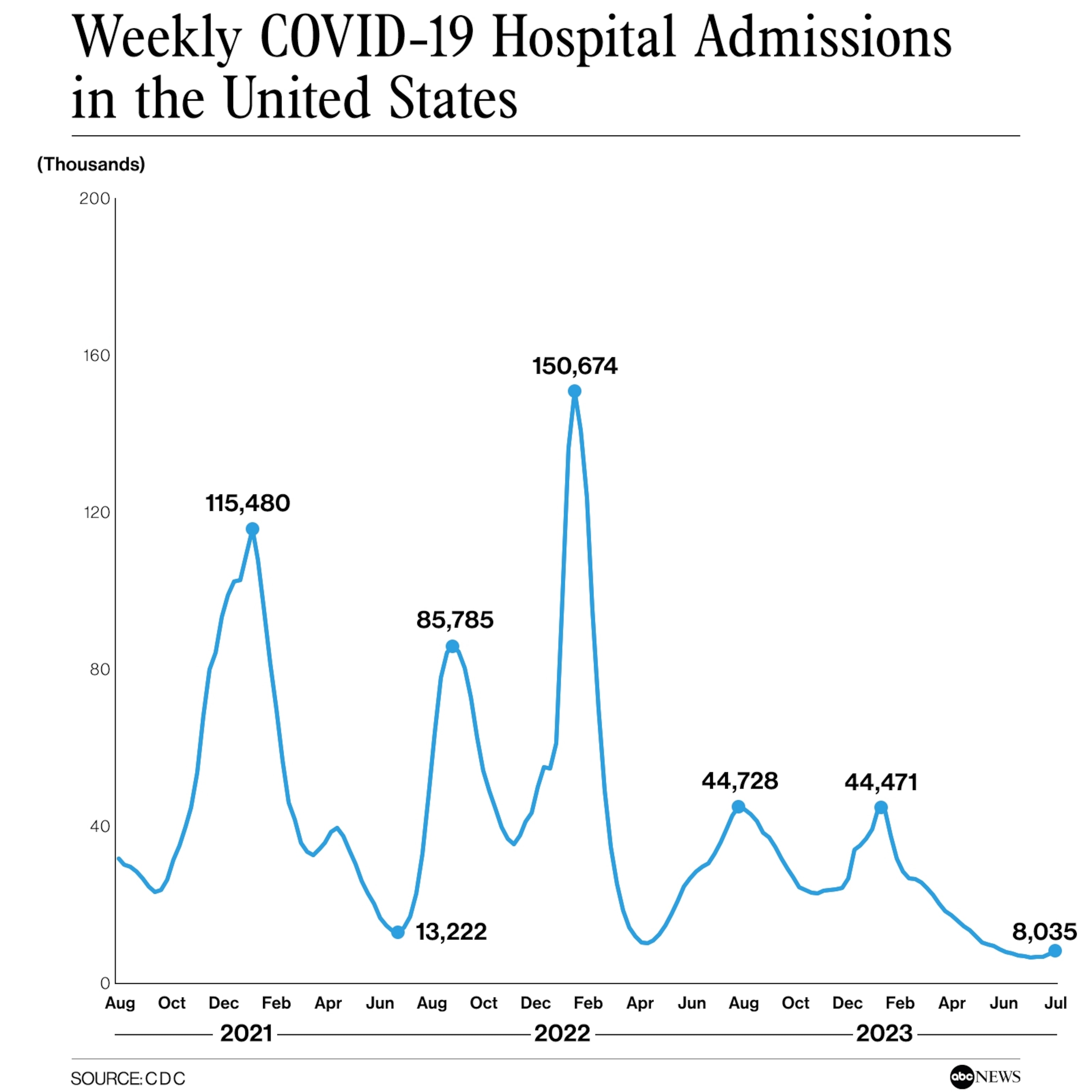Why rising COVID hospitalizations should not necessarily be a cause for concern
Hospitalizations have increased 12% from the previous week, CDC data shows.
After several months of steady declines, COVID-19 hospitalizations appear to be ticking up again.
For the week ending July 22, hospitalizations rose 12% from the previous week from 7,165 to 8,035, according to data released Monday from the Centers for Disease Control and Prevention.
While a double-digit percentage jump may seem scary, experts say these numbers are still among the lowest we have seen since the pandemic began and that there is no reason to panic just yet.
The 8,035 figure is the seventh lowest number of hospitalizations recorded since August 2020 -- the earliest date for tracking weekly hospitalizations.
By comparison, weekly COVID hospitalizations during the peak of the omicron wave in January 2022 stood at 150,674, CDC data shows.
In the past few years, summer months have typically been accompanied by a bump in COVID cases. Experts say this time is different because previous increases involved a more infectious variant, such as delta or omicron, and less immunity from vaccines. This increase, however, doesn't mean a wave is imminent.
GRAPHIC GOES HERE
"Everyone has to remember to take current data with a grain of salt," said Dr. John Brownstein, an epidemiologist and chief innovation officer at Boston Children's Hospital. "There have always been challenges with surveillance like COVID, but that's especially true right now, for a variety of reasons."
This includes fewer resources being put toward COVID surveillance, less testing and people moving on from COVID.
"We have to be also very careful about interpreting changes in hospitalization data," Brownstein, who is also an ABC News contributor, said. "Oftentimes, a percentage increase might seem scary, but when it's off of small counts, the overall burden reflected will still be low in the population."
He added, "Now, these could be signals of a worsening problem and so, from a public health standpoint, we should be looking at this data carefully to understand whether we might see a more significant way of the summer. But it's not time yet to raise the alarm bells about COVID."
The rise in hospitalizations was preceded by an increase in wastewater levels this past month across the country.
National wastewater levels containing traces of the virus have increased nearly 65% in the past month with the Northeast and South experiencing the highest levels.
Most health agencies are no longer tracking cases, which means it's not clear how many Americans are really infected.
"Clearly the wastewater data is going up and we see it as a really good early signal," Brownstein said. "But it could also reflect a lot of low acuity or even asymptomatic cases in the population, in which case, while it's important, it may not be always a direct correlation with the true population burden of COVID."
While wastewater signals community transmission and may serve as a strong proxy to determine how many people are infected with COVID, it comes with limitations, experts say.
Wastewater numbers may be impacted by variables like the number of samples, animal waste, or even rainwater and sometimes do not mirror case counts.
So far COVID deaths have not increased, with 494 deaths reported the week of July 1, the latest date for which data is available according to the CDC. This marks the lowest number reported since the start of pandemic.
This could always change because deaths are traditionally a lagging indicator.

Vaccine manufacturers have been developing booster shots targeting XBB.1.5, an offshoot of the omicron variant that was responsible for a majority of new cases in the past few months.
Health agencies are expected to provide guidance on the updated vaccines later this summer and the shots are slated to hit pharmacies in September.
"We don't have a crystal ball exactly when it comes to COVID," Brownstein said. "I think that all signs point to likely an increase in the fall as people come indoors. Now we'll have a new booster so look for that guidance in September. Uptake in the vaccine booster will help to offset any consequences of any surge."




